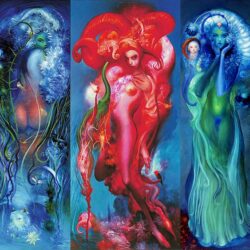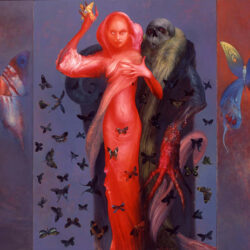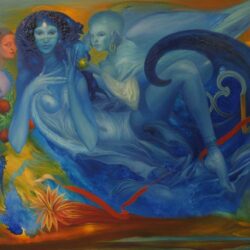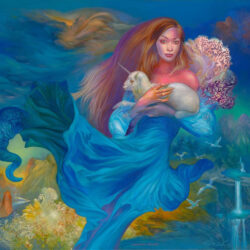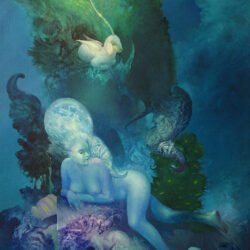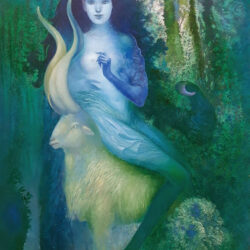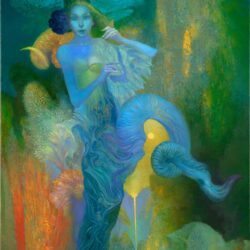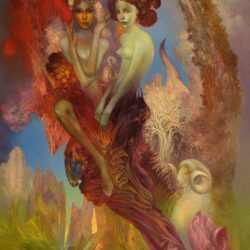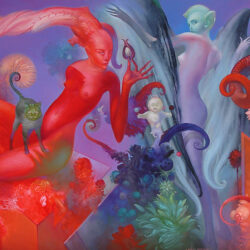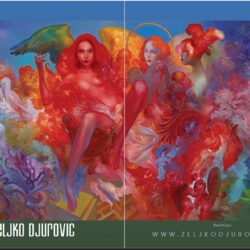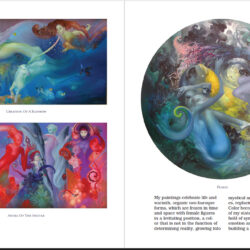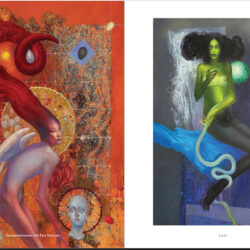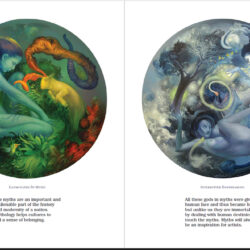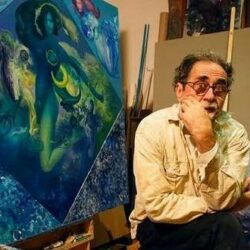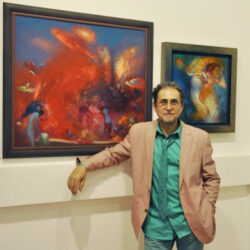If you find love, you’re lucky and If you create art, you have given luck to other people. – Zeljko Djurovic
Q: Your paintings are enchanted by coloristic eroticism, which is guided by the deep command of a being who knows that there is a Beautiful?
A: I like that “coloristic eroticism”. When it comes to my works, it is impossible to avoid the story of eroticism. Everything I drew and painted was for the glory of a woman and the adoration of a woman’s body, keeping myself away from banality and vulgarity, looking there for the most beautiful and exciting. I try to include my emotion into the work and convey it to the observer. I have never painted a male figure, except for a few self-portraits. I fulfilled my dream and search for the perfection of a woman using colors, which are often the subject of controversy among art lovers. It provokes either enthusiasm or criticism.
I have been fascinated by color from the beginning, by color in its original form, and I believe that it is the main driver in experiencing the image and is in a strong connection with other elements. A color that does not belong to the real world contributes to the motif to become extraordinary, displaced from reality and placed in another dimension, the dreamed one. These unexpected color collisions and the way I paint make the picture look fluorescent. I treat color qualitatively and quantitatively, looking for light and energy in it. While painting, I want the observer to get the desire to step into the painting, into that space and to move through the realms of my dreams. My pictures are experienced with the stomach, they are either liked or not. It is the love at first sight.
Color is an erotic element of a painting, as opposed to a masculine drawing, which sometimes has something demonic and cruel. The drawing is my sanctuary and my bastion. I am a consistent combatant for the dignity of drawing as an independent artistic discipline, and not drawing as an everyday recording, sketching or document, but drawing as an independent work of art, smaller or larger format, which is treated as the final work of art. While I creating drawings, I invest a lot of energy, I value them greatly; I try to renew the meaning of the drawing and return it to the art scene, making it even with the painting in terms of creation and complete treatment, as well as in regard to the commercial significance. I love the ink and the pen. As I draw with a pen, scratching paper and pouring ink into that incision somehow reminds me of fertilization and the act of love. By patiently filling in each segment of the paper, we always have in mind a wider idea – composition, tonal relations, line value, accents and rich materialization. As in the painting, so in the drawing, the world is Arcadian, mythical, built exclusively on the ancient and timeless. It seems to me that I also achieved in drawing everything I aspired to in painting, of course respecting the language of the drawing.
Q: The erotic in your paintings sublimates into the spiritual.
A: Of all the quests in the history of mankind, the quest for love is the strongest one. Not everyone is given to find love, not everyone is given to deal with art. If you find love, you are happy, if you create art, you have given happiness to other people. Art awakens positive emotions, delights and makes happy. I believe that emotions drive art. There has always been a question of whether the artist chooses a theme or a theme chooses the artist. I think the topic chose me. From my first painting steps, I was aware of belonging to some strange Arcadian, the world of fantastic painting in which there are no temporal and spatial limitations, where there is no social daily engagement and any destruction. That art fiction with a woman and her eroticism is always in the center, powerful and unrestrained, passionate, wild and innocent at the same time, expressed by artistic means that will not obey any law except the inner dictation of my emotions and boundless trust in encouragement and inspiration sought through daily continuous work. Painting ceases to be a skill of drawing and painting, and it turns into magic in which illusion is always present. The visual sensation that exists in my paintings – drawing, coloring and light seductive at first sight, which is the foreground of the work, grows into a spiritual so that the observer loses real support and dives into the world of the ulterior and spiritual.
The human figure, the figure (in my case of a woman) is a key motif of art, always new and fresh, always a necessary element for learning about the world in which we live. I experience this eroticism and sensuality of women in my paintings quite realistically, almost physically. Out of the search for love and the search for art, I have united them into one mission and I try to persevere in that search with the same passion I had when I started to enter the world of art.
Physical excitement is dominant in all my work, the lustful Eros of healthy love shines far from the dirt and rot of the modern world. The woman is the one who stands at the source and sanctuary of life, erotic and desirable, fertile, inflamed by the fire of temptation or calm by the waves of the sea.
I try to convey that warmth of the Mediterranean united with the beauty and warmth of a woman, to the observer. The woman I’m looking for is that element around which everything revolves. Mother, longing, love, beauty and it will never stop. I constantly want to emphasize that beauty and to fight against doom with beauty and light. I want to beat the verbal game with a visual sensation, which unfortunately is often the other way around in today’s art.
Q: Water gives your image an aura of magic.
A: In my career, I have encountered water topic many times in conversations with audience and critics, and that has always amazed me. Why? I argued that I do not paint water in its apparent form. That was the first reaction because I try not to verbalize and explain the subconscious in me and consciously run away from it even today.
Water brings life, strength and purity both spiritually and physically. Water is life but also death, water is fertility and endless sailing. And endless sailing is also an artistic journey.
I am a Mediterranean by sensuality, eroticism, aesthetics and all other elements and somehow it is normal for me that a woman, a woman’s body, water, sun and stone are imprinted in my genetic code. I felt the first erotic experiences, warmth and smells at the seaside. I made the first drawings in the sand and got annoyed when the wave erased them, but I did not see it as a loss, but as their journey into the blue wideness of water and sky, hoping that someone on the other coast, on the other side, would see them.
The symbol of water also contains the symbol of blood associated with the sun and fire, so that, by painting my most fiery and flaming images with female figures in levitating poses with spiral swaying forms under vibrations of light associated with sifting through water giving them some magic, I experienced that the observer reacts to them as to the underwater motive.
Q: Delusive twilight dark, but also fluorescent painting is soaked with the breath of pagan mysticism of the Slavs.
A: For years I have been developing a system of painting so that color is dominant in my works, my symbolic and painting credo. As a creator, I am completely free to structure my world, the world of my imagination, which does not have to have any points of contact with objective reality. Mysticism in my work is a personal experience subordinated to a subconscious mechanism and as such beyond scientific knowledge and rational understandings. Even if I touch something divine in my work, it is certainly not rational but by the means of intuition and spontaneous feeling.
Q: Everything about you is fairy soft in one cataleptic state between dream and reality.
A: Yes, I would say I am standing on the threshold of some open door. It is that feeling of standing between two realities at the transition between this and the other world, between dream and reality. I feel like I’m on a constant journey and that has been accompanying me all my life. That feeling had to be projected on the composition of my paintings as well.
My paintings celebrate life and warmth, organic neo-baroque forms, which are frozen in time and space with female figures in a levitating position, a color that is not in the function of determining reality, growing into mystical and oneiric experiences, replacing everything real. Color becomes an expression of my state of mind, a stronghold of symbolic thought and emotion and a major factor in building a surreal image.
Q: Shells suggest sensual passion which as a form of a higher temperance has its deep inner logic.
A: The shell is associated with water, fertility and the female sexual organ, as well as mortality. It is this connection of Eros and Thanatos. I don’t think about it, I don’t think about the meaning and symbol of the elements at all, because I don’t want my thoughts to disturb my subconscious functioning and threaten to turn a painting into a mere illustration. The shell as an element is not very characteristic of my painting. I would rather say that the horn is the element that appears more often in my works. At the beginning of my work, just a female figure in an indefinite space existed, in a landscape of the soul. Over time, this content of the painting was enriched by the introduction of flora and fauna, where the horn is imposed as one dominant and recognizable. Of course, everything is in the function of art and building an image using the language of art. In addition to its positive symbolic meaning, the horn is very interesting as a form for research, drawing and painting, and provides countless possibilities for variations. And the shell and the horn are connected as producers of sound, the primordial sound that wraps my images in a mythical Mediterranean space.
Q: Your neo-romanticism carries within it something of the ethereality and softness of the pre-Raphaelite cantilena.
A: I grew up in an environment that abounds with plants and animals, with scents, full atmosphere, emotions and sounds, and that leaves a hallmark. From such an environment in which I spent 18 years, I established and created myself in a large urban environment of Belgrade, where I came to study painting. It is logical that after 20 years of living in Paradise, you will not deal with something that has nothing to do with it. Quite early on, already at the beginning of my studies, I found out what it is that fulfills me and what I want to explore in my painting. When I first encountered fantastic art, our Medial, the Vienna School of Fiction, I realized that I belonged to that family. I met the Pre-Raphaelites later. Their connection with nature and the features of their art such as clear drawing, strong color, erotic elements, and rhythm seduce the observer and everything somehow sings. It connects us. All this, along with one baroque chant, is also found in my painting. All these magical means in the hands of the painter’s wizard with which he narrates by building a picture, prolongs life, makes it more meaningful, beautiful, better because despite all the fears, accidents, surprises and temptations, life is beautiful and should be lived and enjoyed.
Q: In the movement from myth to art, it is shown that it is necessary for the artist to get rid of the dogmatic constants of mythic consciousness.
A: The myths of our and other peoples are important and inalienable part of the history and modernity of a nation. Mythology helps cultures to feel a sense of belonging. All these gods in myths were given a human face and thus became human, but unlike us they are immortal. So by dealing with human destinies we touch the myths. Myths will always be an inspiration for artists. I had one solo exhibition in Switzerland where I dealt with the myths and legends of ancient Greece. How much the artist will manage to overcome the mere illustration of the myth depends on the inspiration and vision of the artist himself. If he holds on the dogmatic, he will not cross the path that leads to art. He must break this dogma not with a literary upgrading but with an artistic transposition.
Q: How do you experience the contemporary moment in Serbian painting and how important is the time in which paintings are created for their adequate perception?
A: I am one of the painters who do not experience the “modern moment”. The modern moment should last and apply to the work as long as it physically exists. I am not interested in daily political art. It seems like fashion to me, from season to season. The work should communicate with the audience regardless of time when it was created. It either touches you or you are indifferent. On my visiting museums and galleries around the world, I witnessed exhibitions of artists or entire movements significant at the moment when they were creating and today they mean nothing, empty, boring without artistic beauty and emotions.
Our artists who created between the two wars are now popular on the art market. But what does that determinant mean? Does that mean that just because they belonged to that period, they are all great artists? Just as there were good and bad artists during the Renaissance, so it was in the interwar period, so it is today. Every period reads the work of art anew every time. And if that timeless button with the part is found, then it is the right one.
Art is on the margins in our country, it has almost become unimportant. The state invests little in it. Every success (although it is questionable what success means, in the end it comes down to the successful sale of his works on the foreign market) of the painter at the international level is at the level of an incident, with great efforts and engagement of the artist himself.
Artists in the area of visual art are left to a sheer market economy. It is not easy for young artists, and there are a lot of good young painters. If they oppose the “new normalcy” imposed by globalism and the relativization of all values through sincerity, humanity and the true qualities of a human person and remain consistent with their aesthetic principles, they will acquire their place.
Zeljko Djurovic’s website: www.zeljkodjurovic.com





